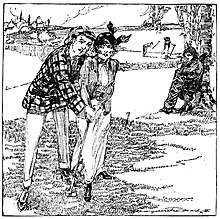Caddie
In golf, a caddie (or caddy) is the person who carries a player's bag and clubs, and gives insightful advice and moral support.


Description
A good caddie is aware of the challenges and obstacles of the golf course being played, along with the best strategy in playing it. This includes knowing overall yardage, pin placements and club selection. A caddie is not usually an employee of a private club or resort. They are classified as an "independent contractor", meaning that they are basically self-employed and do not receive any benefits or perks from their association with the club. Some clubs and resorts do have caddie programs, although benefits are rarely offered. Particularly in Europe, the vast majority of clubs do not offer caddies, and amateur players will commonly carry or pull their own bags.
The first caddies appeared in 1817 in Edinburgh. It is believed that the first use of a caddie was by The Duke of Albany of Scotland in 1681 while playing the first international golf contest at Leith Links, which resulted in the construction of Golfers Land in Edinburgh.[1]
Etymology
The Scots word caddie or cawdy was derived in the 17th century from the French word cadet and originally meant a student military officer. It later came to refer to someone who did odd jobs.[2][3] By the 19th century, it had come to mean someone who carried clubs for a golfer, or in its shortened form, cad, a man of disreputable behaviour.[4]
Types of caddying
Traditional caddying involves both the golfer and the caddie walking the course. The caddie is in charge of carrying the player's bag, keeping the clubs clean, and washing the ball when on the green, and walks ahead of the golfer to locate their ball and calculate the yardage to the pin and/or hazards. Sometimes, a caddy is asked for opinions such as what/where to hit or where to aim a putt. This is the most common method used in golf clubs and is the only method allowed in the PGA (Professional Golf Association) and LPGA (Ladies Professional Golf Association). The three usual "ups" of caddying are: show up, shut up, and keep up.
Fore-Caddying entails the caddie walking while the players ride in carts. The fore-caddie will give a hole description and then walk ahead to spot the players' tee shots. The caddie then gets the player's yardage (either with a GPS watch, laser, course knowledge, or sprinkler heads) while the players drive their carts from the tee to their shots. The caddie walks ahead again to spot the golfer's next shots. This process is continued until the players reach the green. Once on the green the caddie will read greens (if asked per proper golf etiquette), clean golf balls (if asked), fix ball marks, and attend the flag. The usual rule is that the first golfer on the green's caddy tends the flag. The caddie is also responsible for raking traps on the course. Caddies may be asked to help with club selection, reading greens, weather variables, and marking balls on the green. More than anything else, the caddie is there to make the player's round enjoyable by taking care of menial tasks, speeding up play, and providing mental support if asked.
Caddie ranks
Many clubs use a ranking system. Caddies will start as a trainee, and be promoted through the ranks of Intermediate, Captain, Honor, and finally Championship. Many courses start their caddies off at the B level, and after a year move them to A, and on their fourth year (if they have earned it), they will receive the title of Honor caddie. The intermediate and captain ranks can usually be obtained within the first year of caddying, and the honor rank is usually obtained in the second or third year of caddying. Championship takes at least 6 years and often as many as 10 years to obtain. An alternative ranking system often used in the American Mid-West proceeds as B level, A level, AA level, Honor level, and Evans Scholar. Caddies often obtain a promotion in rank once a year, while often Honor takes two years to achieve and Evans Scholars are only produced by winning the venerable Evans Scholarship for university. However, in many American clubs, caddies are divided simply between "B" caddies (usually younger, less experienced caddies who often carry only one bag), and "A" caddies (usually older, more experienced caddies).
Day of a caddy
Caddies report early each morning at the "Caddy Shack" where they wait until the caddie master assigns them to a golfer. At that time, they retrieve the golfers bag (typically from the bag room) and wait to meet the golfer out in an open area. When done with the morning round of golf (a loop), the caddie can either wait to work an afternoon "loop" or go home. Sometimes caddies show up late in the morning to only work afternoons where some days of the week it can be pretty slow in the morning.
Weekly schedule
Caddies typically work at clubs all week except Mondays with most traffic on weekends, being the busiest days. Additionally, caddies are often allowed to play the course at which they caddie for free, usually on a Monday (the day that most private clubs choose to close their course for maintenance). On pro golf tours, professional caddies accompany their player to all events, which usually take place from Thursday through Sunday. Additionally, the player may hire their caddie to carry their bag for them during training sessions and practice rounds.
Pay scale
At most clubs, caddies are paid at the end of the round by cash, or receive a payment ticket for which they can redeem their wages in the clubhouse. Generally, the player will tip the caddie based on their performance during the round, with extra money given for exemplary work or for working special event such as a tournament. Most American club caddies earn between $80 and $120 per bag, though newer caddies will often earn less than more experienced caddies. Caddies working during a tournament, high-stakes match, or 4-Day member-guest will often earn significantly more, upwards of $150 per round, per bag, at times. It is common for experienced caddies to carry two bags (a "Double") at a time. It is considered acceptable to ask a professional at the course what the average pay for a caddie is, as courses differ.
In a professional golf tour setting, a player often pays their caddie a percentage of their winnings, which can be as high as 10 percent. A common pay scale is 5 percent for making the cut, 7 percent for a top 10, and 10 percent for a win. The caddie also usually receives a salary, as the player is not guaranteed to win money at every tournament.
Beginning in the 2020 season, caddies on the European Tour will be eligible to earn bonuses through sponsors' logos on hats, bags, towels, and other caddie tools.[5]
In popular culture
Caddies have been depicted in TV, films, and books, including:
- The Caddy, a 1953 musical comedy film starring Dean Martin and Jerry Lewis.
- McAuslan in the Rough, a 1974 short story by George MacDonald Fraser in which a disreputable Scottish soldier caddies for his regimental sergeant major.
- Caddyshack, a 1980 comedy film featuring Bill Murray, who worked as a caddie while in high school.
- Brown's Requiem, a 1981 crime novel by James Ellroy, who worked as a caddie while writing his first books.
- Loopers: The Caddie’s Long Walk, a 2018 documentary narrated by Bill Murray.[6][7]
References
- https://www.atlasobscura.com/places/golfer-s-land
- "caddie, noun". Merriam-Webster Dictionary. Merriam-Webster, Incorporated. Retrieved 25 February 2019.
- "Caddie". Oxford Dictionaries. Oxford University Press. 2019. Archived from the original on 25 February 2019. Retrieved 25 February 2019.
- "The Strange Route from 'Cadet' to 'Cad'". Merriam-Webster, Incorporated. Retrieved 25 February 2019.
- "Why a Golf Caddie Group Set Up a Sponsorship Program for Its Members". Associations Now. 2020-01-15. Retrieved 2020-01-15.
- Beall, Joel (23 January 2019). "Bill Murray narrates new film that explores the lives of caddies". Golf Digest. Condé Nast Publications. Retrieved 25 February 2019.
- Howell, Andy (15 February 2019). "Loopers: The Caddie's Long Walk". Film Threat. Retrieved 25 February 2019.
External links
| Wikimedia Commons has media related to caddies. |
| Look up caddie or caddy in Wiktionary, the free dictionary. |
- European Tour Caddies Association
- "Caddies making a comeback", The Seattle Times
- "Notes from the Caddieshack" - a McSweeney's Internet Tendency column about being a caddie in the Chicago suburbs